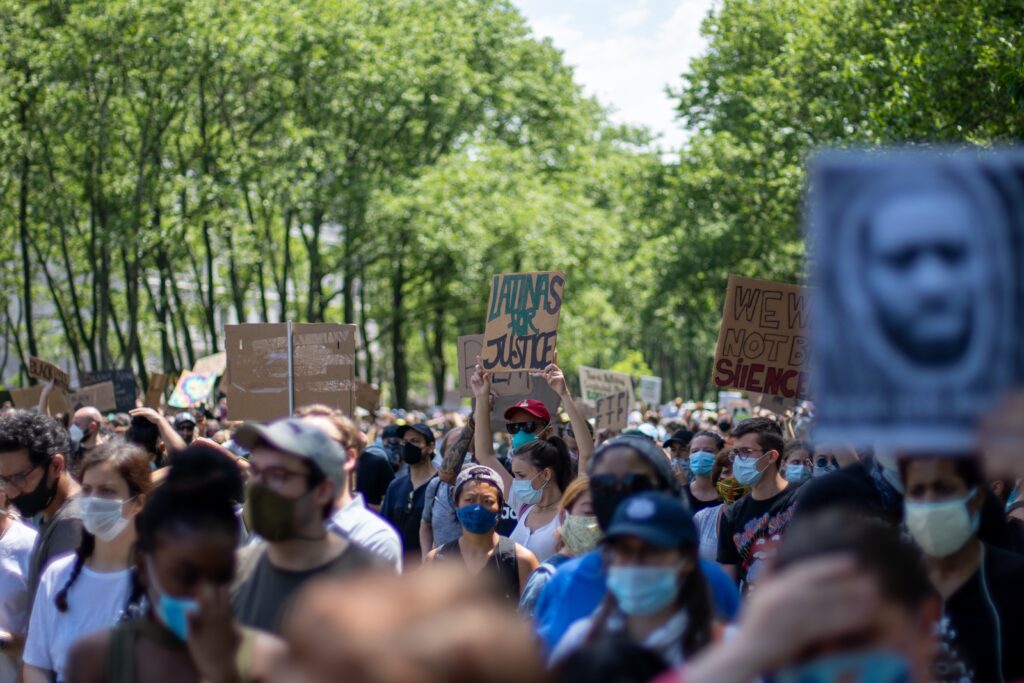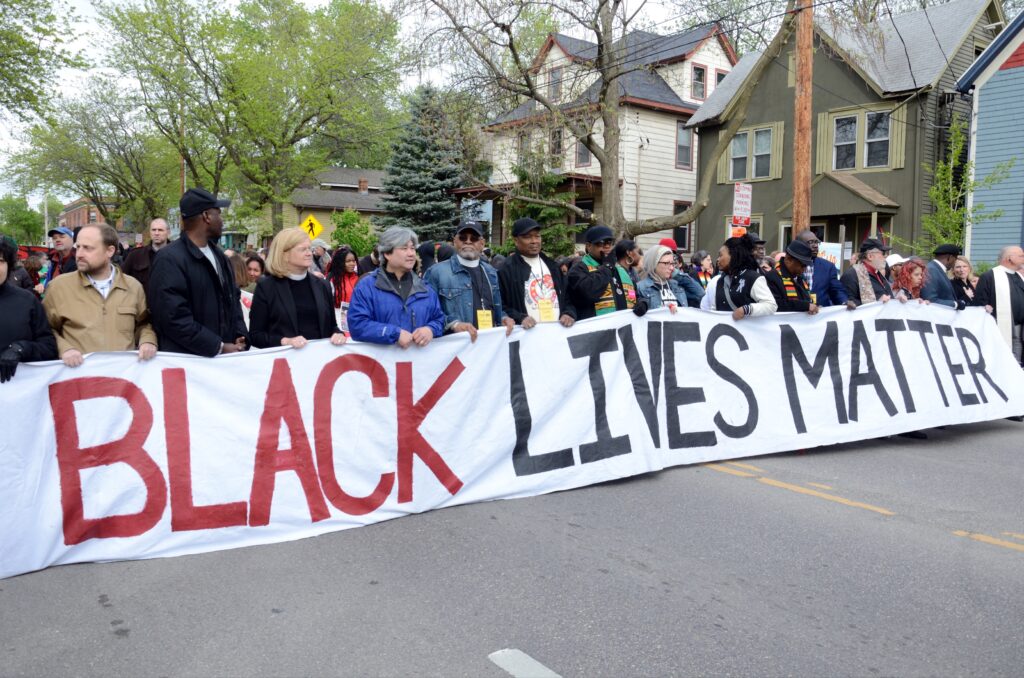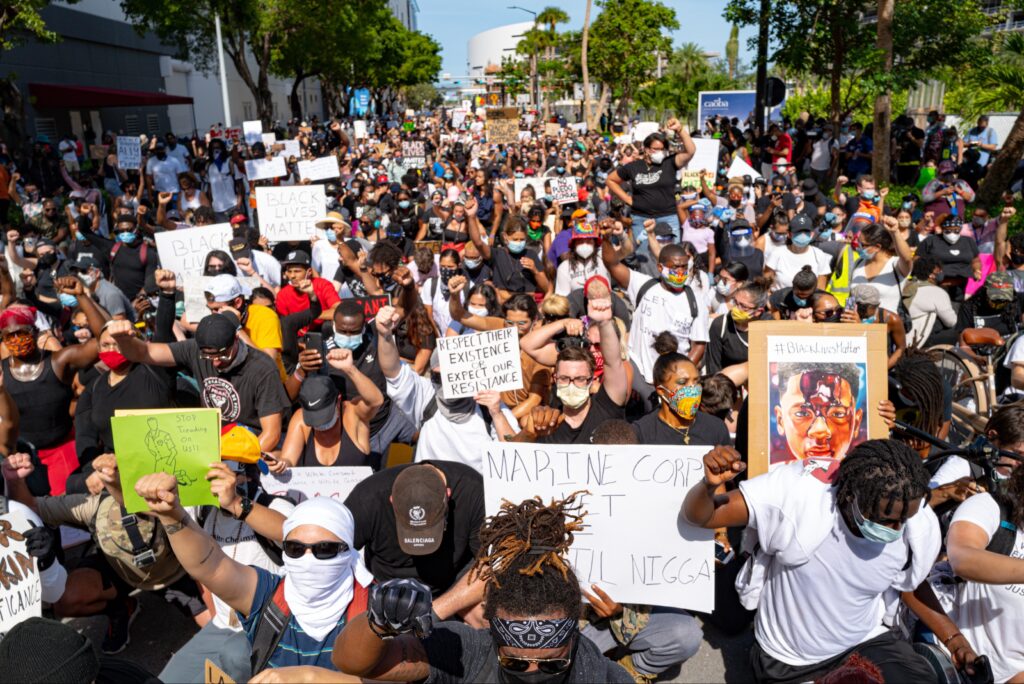Is it socially responsible to protest in the time of Corona?
It’s been over three months since the Corona virus has taken a central place in our lives, deeply affecting our lifestyle, the way we work, how we engage with our family, our community, our workplace, etc. Our news consumption has also been centered around COVID-19, and just as we started getting used to the “new normal”, a new wave, one seemingly so stark in contrast, has spread across the globe. Mass protests, thousands of people taking to the streets, defying lockdown rules against large gatherings, social distancing, and stay home regulations.
#BlackLivesMatter protests that were sparked by the murder of George Floyd, a black man, by Minneapolis police officers, spread to all 50 states and over 75 cities across the United States, in what has been deemed the “most turbulent social upheaval since the assassination of Martin Luther King Jr. in 1968”. This was the same week that the US crossed the 100,000 COVID-19 death count.
The global health crisis did not stop thousands from taking to the streets. These protests against police brutality towards black people grew to encompass systemic injustices against black communities in the US, and outside the US, as Black Lives Matter protests spread to major cities across the globe. Mass protests erupted from London, Paris, Amsterdam, Berlin, Copenhagen, Dublin, Milan, to Auckland, Toronto, Perth, Rio de Janeiro, Mexico City, and even Idlib, Syria.
Governor of New York, Andrew Cuomo, at a press conference said: “You have a right to demonstrate, you have a right to protest … You don’t have a right to infect other people, you don’t have a right to act in a way that’s going to jeopardize public health.”
The question becomes:
Is it socially responsible to protest in the time of Corona?
Can protests occur without risking a spike in the spread of COVID-19?

Supporting Arguments:
Both the protests and the pandemic response are the same – saving lives.
The risks can be mitigated
- The protests are vital to national public health, and especially to the threatened health of black communities in America. Facilitating the safest protesting policies can occur without detracting from protesters’ ability to gather and demand change. Protest leaders, politicians, movements, and activists have been posting ways in which you can safely protest.
- The New York City health department took to Twitter to offer these tips to protesters: “Wear a face covering, wear eye protection to prevent injury, stay hydrated, use hand sanitizer, don’t yell; use signs & noise makers instead, stick to a small group, keep 6 feet from other groups.”
- Many of the demonstrators were wearing masks, and in some places, appeared to be avoiding gathering too closely. Allies have been facilitating safe demonstrations by providing masks, face shields, goggles, hand-washing stations, and hand sanitizers to demonstrators. They have also been donating to bail funds for protesters. Additionally, chalk markings can be used to encourage appropriate distancing between protesters.
- It is the police response that is exacerbating the situation – crowding, penning and trapping hundreds of protesters into confined and enclosed spaces, detaining and jailing protesters, tear gassing protesters, etc.
- If local governments demand law enforcement officials stop using tear gas, smoke, or other respiratory irritants; demand that police officers and national guard wear masks, maintain distance from protesters, and stop holding protesters in confined spaces, or tunnel them into confined spaces, that would significantly reduce the problem, instead of trying to stop vital protests.
- The onus is on local governments to support health officials, so they are prepared, and can provide increased access to testing and care for people in the affected communities, rather than support the police in its mishandling of the protests.
- Institutional failures have done more damage than the protests, and local governments (pressured by businesses) are loosening restrictions on businesses and gatherings without them having even met the criteria around reductions in COVID-19 cases.
- The pretext of public health should not be used to curb constitutional rights but is sadly being used around the world by more authoritarian regimes to expand their power and decrease civilian liberties.

Even if the risks are too high, the protests are justified
- Some injustices are too great to remain silent about, or wait until a “better time” to address.
- The fact that black men in America fear wearing a mask (for their own protection from COVID-19), more than COVID-19 itself is telling. The fact that getting killed by the police is the leading cause of death for young black men in America (1 in 1000 black men are killed by the police), and the fact that the police always seem to evade the long arm of the law, and justice is rarely served is just the tip of the structural inequality iceberg.
- The necessity of fighting police brutality and racism is obvious – but some will still say we should wait. The same struggle, the same slogans, the same stories have been building for decades, and nothing is changing. This was the straw that broke the camel’s back and sparked a global response, that has finally led to the exposure of the police for what they were, achieved results (arrests ongoing), this is the time to build on momentum and push for changes, just like the 1968 protests post Martin Luther King’s assassination that forced the state to take notice and systemic changes to be made.
- The global health crisis has not stopped forms of injustice, rather it has shed more light into the stark disparities, it should not stop people protesting these injustices
- Protesters went out en masse at great risk to themselves, from police violent retaliation, to COVID-19 because they realize the cause is greater than that.
- The risks become acceptable, as the damage being caused by not taking action outweighs any supposed benefit of not taking them.
- These protests are currently the primary channel (after trying everything over the course of years and decades) to keep the government accountable for its systems that have led to the loss of black lives at the hands of police brutality as well as COVID-19.
There is no dichotomy between trying to control COVID-19 and trying to curb racism
- Protesters are protesting to protect themselves from a health crises
- Police brutality and the corona virus pandemic are both public health stories, and what links the two is systemic racism. The structural racism that enables police brutality in black communities is the same one that is responsible for the disproportionate manner in which communities of color have been hit with COVID-19.
- Many health experts have supported the protests as they realise the direct threat systemic and structural inequality and racism poses to the health of black and POC communities. As Abraar Karan, Harvard Medical School, said “If you point your fingers at a symptom, which is a protest, you’re missing the root cause, which is systemic racism”
- Black people are more likely to develop COVID-19, and Black people with COVID-19 are diagnosed later in the disease. Black people are two to four times more likely to die from COVID-19 compared to their white counterparts. African Americans account for 13% of the population, but a quarter of all COVID-19 deaths were black people. (COVID Racial Data Tracker)
- The African American COVID-19 death rates are higher than their percentage of the population (66% of deaths, 41% of population). In Chicago, Illinois, African Americans account for 29% of population, but have suffered 70% of COVID-19 related deaths. Of the first 100 COVID-19 deaths in Chicago, 70 were African American. In Illinois (43% of deaths, 28% of infections, 15% of population), and Louisiana (46% of deaths, 36% of population). (Journal of Law and Bioscience)
- These disparities are a result of historical and current practices of racism that cause disparities in exposure (more black workers deemed essential workers), susceptibility (black communities are more at risk due to health conditions like heart disease, blood pressure, diabetes, asthma, etc. – also health risks that affect them disproportionately) and treatment (testing sites are concentrated in whiter areas)
- What this means is that for a majority of black people in the US, staying at home and socially distancing to protect themselves from COVID wasn’t even an option. Racial minorities account for 75% of essential workers (grocery clerks, bus and train operators, janitors and child care staff, etc) unable to work from home, leave their job, or access paid sick leave. They live in denser, often more polluted neighborhoods (a result of unjust housing policies) and rely on public transportation. They live in the hardest hit areas (NYC – minorities and poor neighborhoods have the highest COVID-19 cases). Their access to healthcare is limited, as most do not have health insurance; they are tested less frequently than their white counterparts are, most postpone hospital trips (either due to work, or a mistrust of the system, believing they can’t access the help)
- The forces that put many minority communities at risk of police violence have also put them at risk during a pandemic. Years of diminished economic opportunity, of marginalization, of structural racism, have led to both.
- One cannot separate between the two, for black communities, they are deeply interrelated. For black communities, unless these structural grievances are addressed, their health and lives are at risk.
- The risk of COVID-19 numbers rising is a concern, but it was always one for the black community, along with violence and death.
- Confronting the structurally racist system is confronting the system that puts African Americans at higher risk of dying from COVID-19. “Structural racism has been a public-health crisis for much longer than the pandemic has.” (Maimuna Majumder, Harvard Medical School)
Opposing Arguments:
The virus doesn’t distinguish between a righteous or non-righteous cause, it will spread and infect anyone.
The risk is too high
- Most states and countries have rules that limit crowds to up to 12 individuals, these protests consist of thousands, in close proximity, for extended periods of time.
- Although the protests are in open spaces, and some say this reduces the risk, however being outside doesn’t reduce the risk that much. COVID-19 is transmitted through respiratory droplets that are spread when people talk, cough, sneeze, etc. Protesters are chanting, shouting, yelling. Some are wearing masks, many are not, and even those who are wearing masks are not wearing goggles.
- Emotions run high at these events, and protesters lose awareness of who they are around, how close they are, whether they are wearing masks, etc.
- To make things worse, tear gas and pepper spray used by the police to disperse crowds causes them to tear up, cough, and increases secretions from the eyes, nose and mouth, all increasing the risk of transmission and spread.
- Again, arresting, transporting and detaining protesters by the police makes for more instances of people in confined spaces further exacerbating things.
- Medical historians have likened these protests to the Bond parades in Detroit and Philadelphia during the 1918 influenza pandemic, which were followed by spikes in cases.
Saving lives should be the priority
- Although the protesters grievances are valid, and their cause a worthy one, the virus doesn’t distinguish between a righteous or non-righteous cause, it will spread and infect anyone.
- Public health researchers say that the decrease in cases in the US that had been slowing had spiked and they are now diagnosing more new COVID cases since the pandemic began.
- According to John’s Hopkins, Sunday alone saw an increase of almost 20,000 cases nationwide. In the last week, 18 states saw an increase of at least 10% of cases.
- The COVID-19 outbreak which had initially hit the denser coastal cities in New York, California, etc. has now seen much wider spread in the inland states like Arizona, Arkansas, Texas, etc.
- The main priority should be to save lives and protect not just the protesters, who some claim are younger and are at less risk, but also who they may go on to infect, especially given more than half of corona virus infections are spread by asymptomatic people, who may or may not develop symptoms, and don’t know that they are sick. (Harvard Global Health Institute)
Delay of relaxing lockdown rules and its consequences

- As the numbers go up, and the cases start to spread, more states will be forced to delay their plans for re-opening and relaxing lockdown rules.
- Washington DC on Monday reported a new peak in cases, delaying a move from phase one of their reopening program to a less restrictive phase
- Philadelphia’s planned “yellow phase” of lessened restrictions, which would lift the stay-at-home order and allow restaurants to resume some dine-in service, have been delayed due to unrest.
- Chicago is still discussing whether it will go forward with entering Phase 3 of its reopening, which would allow for barbershops, offices and retail businesses, among others, to reopen.
- Over 3 million Americans, mostly from minorities, have filed for unemployment, mostly due to lockdown measures causing businesses to go under, with job losses mostly affecting precariously employed, low-paid laborers who have little savings or capacity to wait out the lockdown.
- The longer the lockdown continues due to a resurging risk of COVID-19, the longer these vulnerable groups stay trapped in their desolate situations.






Leave a comment